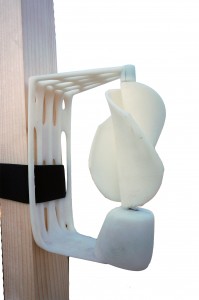Our first idea was to create a generator of energy by wind, which does not necessarily interfere
with the existing building but rather could be sued or adapted according to different needs and
requirements.
We consider the verticality as an element to be developed within the aesthetic capabilities of a
purely mechanical system and simultaneously exploit the flexibility benefit of not needing to be
addressed the wind turbine according to downwind.
Our first prototype:
We putted in place everything we have investigated. the making and testing process, the
properties, the advantages and the problems we found when we were making our first prototype,
we found different problems regarding three main factors:
1. Proportion and Dimensions.
2. Geometry
3. Mechanics
[ At this stage, electronics were not important component of the making process however we have
tested the production of energy].
Conclusions:
We focus on improving the design of the wind turbine towards efficiency. Understand its geometry
and to create something pleasant for the viewer.
The design of the wind turbine become our main objective because we need to produce certain
amount of energy where aesthetics and functionality become our main objective.
Our ideas of intervention required a series of small wind turbines which means, solving this issue,
our ideas of intervention will be realizable.
Valldaura as a place of intervention.
Walking through Valldaura we found some existing natural tensions that bind the building
structures and the green structures that are not fully tapped but have created continuity and
connection.
Our intervention was conceived as something that should incorporate the surrounding landscape
into the existing building.
We went trough different approaches were we incorporated basic concepts of vertical elements
were you can combine a series of small wind turbines [ VAWT ].
After Mid-Term presentation the conclusion was to focus in the develop of the smallest and efficient
Wind Turbine we can produce based in our research and the initial idea of the combination of
many of them to produce energy in a serie system or parallel system.
For the initial testing and analysis we had developed series of 3D models by hand using digital
tools like laser cutters but we decide to focus our research using exclusively 3D printer machine
which allow us to produce the complete kit [ only electronics comes apart ] easy to assemble and
to generate something that could be printed and used anyplace in the world with basic
instructions.
DESIGN AND DIMENSIONS
The design is based in 3 wings wind turbine. The wings have been change it according to aerodynamic analysis, air flow calculations, and empiric test with some prototypes.
Prototypes have been made in two 3D printer machines: Makerbot and the Project 1500. Project 1500 allow us to have more definition on the surface and on the edges, which makes huge improvement in aerodynamics.
The thickness of the wings are going to be tested in the Project printer 1500, because the delays from the availability of the 3D printer machine. We decided to test the thickness in other components of the project like the fairing and structural components. We found we can decrease the thickness of the wings to 1 mm which is going to reduce the weight, wind resistance, therefore the speed of the wind turbine.
We have tested gears system with the conclusion of avoid to use it at this stage because the huge
increase in the momentum -torque-, any benefit using gears are not reflected.
With the connection of two propellers we can charge 4 batteries AA and be able to charge any
kind of electronic of 5V like MP3 music [iPod] , Smart Phones [iPhone], Tablet [iPad], Systems
based on Arduino [Smart Citizen] any kind of system based in USB charger.
Even they required 500mAh – 600mAh to get charge, we are looking for stepper or jumper
systems which are not available in Barcelona like mintyboost or similar.
The lack of Amperes means the time of charging the batteries is going to be longer than with
more mAh.
 THE FINAL PROTOTYPE
THE FINAL PROTOTYPE










